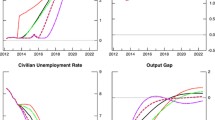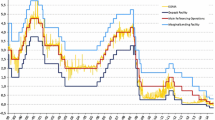Abstract
The present paper employs a partially generalized ordered probit method to model the Federal Reserve’s monetary policy reaction function. The partially generalized ordered probit method eliminates the parallel regression assumption (which is assumed in ordered probit models) and reveals an important new asymmetry in the Federal Reserve’s actions. The findings indicate that a general monetary reaction function outperforms standard Taylor rule specifications. The Fed takes into account not only inflation and output measures but also several other variables during its decision process, but the degree of its attention on each variable is choice-dependent. The Fed might assign different weights for each macroeconomic factor when it is trying to make a choice, for example, between a big and small decrease or a small decrease and no change in the federal funds target rate. The threshold estimates also indicate that the Federal Reserve acts asymmetrically that it waits for relatively significant changes in the macroeconomic factors before it decides for a change in its target rates. However, once these thresholds are passed, relatively less significant changes in the economy are needed for the Federal Reserve to take action.

Similar content being viewed by others
Notes
There are several reasons to believe for non-quadratic loss functions. For more detail see Dolado et al. (2005).
He argues that the FOMC began targeting the funds rate before 1994 and constructed the target series using reports such as the verbatim transcripts of FOMC meetings, the FOMC Blue Book, the Report of Open Market Operations, Money Market Conditions, and etc.
The test results are listed at the bottom of each table.
Actually, it is −0.021 but it is statistically insignificant.
Results for the ordered probit and generalized ordered probit models are not reported to save space and are available upon request from the author.
References
Aksoy, Y., Orphanides, A., Small, D., Wieland, V., & Wilcox, D. (2006). A quantitative exploration of the opportunistic approach to disinflation. Journal of Monetary Economics, 53, 1877–1893.
Blinder, A. (1998). Central banking in theory and practice. Cambridge, MA: MIT Press.
Clarida, R., Gali, J., & Gertler, M. (1998). Monetary policy rules in practice: Some international evidence. European Economic Review, 42, 1033–1067.
Clarida, R., Gali, J., & Gertler, M. (2000). Monetary policy rules and macroeconomic stability: Evidence and some theory. Quarterly Journal of Economics, 115(1), 147–180.
Cukierman, A. (2000). The inflation bias result revisited. Mimeo: Tel Aviv University.
Cukierman, A. (2004). Non linearities in Taylor rules—causes, consequences and evidence. Working Paper.
Dolado, J., Maria-Dolores, R., & Naveira, M. (2005). Are monetary-policy reaction functions asymmetric?: The role of nonlinearity in the Phillips curve. European Economic Review, 49, 485–503.
Dueker, M. (1999). Measuring monetary policy inertia in target fed funds rate changes. Federal Reserve Bank of St. Louis Review, 3–10.
Florio, A. (2006). Asymmetric interest rate smoothing: The fed approach. Economics Letters, 93,(2) 190–195.
Di Giorgio, G. (2014). Monetary policy challenges: How central banks changed their modus operandi. Eurasian Economic Review, 4(1), 25–43.
Hamilton, J., & Jorda, O. (2002). A model of the federal funds rate target. Journal of Political Economy, 110(5), 1135–1167.
Hu, L., & Phillips, Peter C. B. (2004). Dynamics of the federal funds target rate: A nonstationary discrete choice approach. Journal of Applied Econometrics, 19(7), 851–867.
Keynes, J. M. (1936). The general theory of employment, interest and money. London: Macmillan.
Levin, A., Wieland, V., & Williams, J. C. (1999). The robustness of simple monetary policy rules under model uncertainty. In J. Taylor (Ed.), Monetary policy rules (pp. 263–299). Chicago: Chicago University Press.
Long, S & Feese, J. (2006). Regression models for categorical dependent variables using Stata (2nd ed.). College Station: Stata Press.
Neftci, S. (1984). Are economic time series asymmetric over the business cycle? Journal of Political Economy, 92(2), 307–328.
Orphanides, A. (2001). Monetary policy rules based on real-time data. American Economic Review, 91, 964–985.
Orphanides, A., & Wieland, V. (2000). Inflation zone targeting. European Economic Review, 44(7), 1351–1387.
Orphanides, A., & Wilcox, D. (2002). The opportunistic approach to disinflation. International Finance, 5(1), 47–71.
Petersen, K. (2007). Does the Federal Reserve follow a non-linear Taylor rule? University of Connecticut Department of Economics Working Paper Series, 2007-37.
Qin, T., & Enders, W. (2008). In-sample and out-of-sample properties of linear and nonlinear Taylor rules. Journal of Macroeconomics, 30(1), 428–443.
Rudebusch, G. D. (2002). Term structure evidence on interest rate smoothing and monetary policy inertia. Journal of Monetary Economics, 49(6), 1161–1187.
Shirai, S. (2014). Japan’s monetary policy in a challenging environment. Eurasian Economic Review, 4(1), 3–24.
Soderlind, P., Soderstrom, U., & Vredin, A. (2005). Dynamic Taylor rules and the predictability of interest rates. Macroeconomic Dynamics, 9, 412–428.
Taylor, J. B. (1993). Discretion versus Policy Rules in Practice. Carnegie-Rochester Conference Series on Public Policy, 39, 195–214.
Taylor, M., & Davradakis, E. (2006). Interest rate setting and inflation targeting: evidence of a nonlinear Taylor rule for the United Kingdom. Studies in Nonlinear Dynamics and Econometrics, 10(4), 1–20.
Thornton, D. (2005). A new Federal funds rate target Series: September 27, 1982–December 31, 1993. Federal Reserve Bank of St. Louis Working Paper 2005-032A.
Vanderhart, P. (2000). The Federal Reserve’s reaction function under Greenspan: An ordinal probit analysis. Journal of Macroeconomics, 22(4), 631–644.
Author information
Authors and Affiliations
Corresponding author
Rights and permissions
About this article
Cite this article
Danis, H. Nonlinearity and asymmetry in the monetary policy reaction function: a partially generalized ordered probit approach. Eurasian Econ Rev 7, 161–178 (2017). https://doi.org/10.1007/s40822-017-0069-x
Received:
Revised:
Accepted:
Published:
Issue Date:
DOI: https://doi.org/10.1007/s40822-017-0069-x




